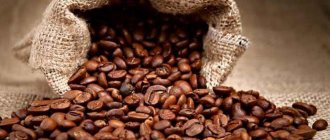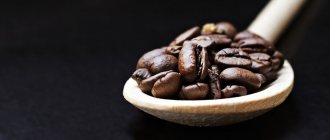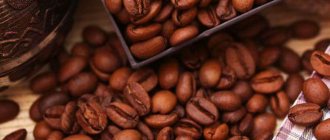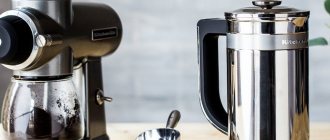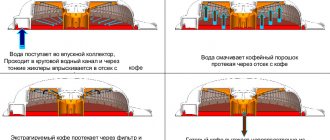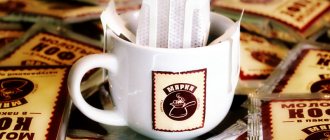Taste
At first glance, Arabica and Robusta are quite close relatives, they even belong to the same Madder family.
The main difference between Arabica and Robusta is taste. The first type is considered softer, slightly sour. Arabica can have several shades, depending on the variety:
- fruit;
- astringent, as if with spices;
- floral;
- walnut;
- chocolate;
- berry.
Robusta will appeal to connoisseurs of strong and tart coffee. After roasting, the taste becomes slightly less bitter. A characteristic feature of this type is considered to be stable volumetric foam. Robusta is suitable for espresso lovers.
Chemical composition of grains
Arabica beans produce a drink that is less strong, with a rich taste and aroma.
Robusta produces a sharp, bitter, but very invigorating infusion with a faint odor. Arabica beans contain a large amount of essential oils. The percentage of their content reaches 18%. And there is only 1.5% caffeine. After roasting, the grains are valuable for vitamin PP. Arabica also contains lipids, proteins and sugars.
Robusta is translated as “strong”, since the concentration of caffeine in it is 2 times higher than in Arabica - 3%. And there are only 8% essential oils, which explains the lack of a strong smell and taste. Roasting the beans before preparing the drink softens the bitterness slightly. A high concentration of caffeine gives a good invigorating effect, and the tart taste stimulates the receptors. As a result, a person feels less tired, so this drink is usually consumed in the morning.
Rating of the best Robusta coffee
Some lovers prefer to drink one brand of coffee for years, while others turn into incorrigible experimenters, trying different products in search of the best option.
The hardest thing is for beginners who don’t know what to choose, although this problem can be completely solved by studying the ratings of the best coffee, compiled according to reviews of coffee lovers:
- Robusta Uganda. Dry processing method. Pronounced chocolate taste without sourness, but with noticeable astringency and bitterness. Coffee has a higher strength and is ideal for an invigorating effect.
- Torrefacto India Parchment in grains. Ideal for brewing in a Turk, French press and various types of coffee machines. Taste with chocolate-nut notes and cocoa. There is a bitterness characteristic of the variety.
Italy produces excellent coffee
- Lavazza Gusto Forte. Vacuum-packed, dark-roasted whole beans intended for making espresso. It has a sourish-bitter taste and increased strength.
- And Coffee. A high strength drink with a pronounced invigorating effect. Ideal for morning use. Taste with pronounced bitterness, but without acid.
Robusta contains a large amount of caffeine, providing strength and that signature bitterness
Popular varieties
Arabica requires cross-pollination, hence the rapidity of infection and mutation.
Arabica may be mistakenly called a coffee variety. But in fact it is a type of plant. And the most popular varieties of coffee made from it include:
- Bourbon;
- Shinzan;
- Maragogyp;
- Typica;
- Bali;
- Katura;
- Aramosa.
Each variety has a characteristic taste and aroma. Arabica is very common and is considered a classic coffee, which is why there are so many varieties. There are significantly fewer varieties of Robusta:
- Conillon du Brazil (characteristic earthy flavor);
- Ambry (classic variety);
- Quilu (more often used in mixtures than solo).
Each variety was grown for its own purpose. Some reveal the taste of the drink better, while others grow and ripen faster. There are more varieties of Arabica, but Robusta also has plenty to choose from.
Coffee regional studies
Brazil is the most famous and largest coffee producer in the world. There are at least 4 million coffee trees growing on Brazilian plantations! The main type of product that Brazil supplies is Arabica. At the same time, Brazilian companies export the product in the form of:
- green grains;
- roasted grains;
- ground raw materials;
- soluble;
- sublimated;
- granular
It’s safe to say that coffee from Brazil is the most widespread and most consumed, but quantity in this case played against quality. At least, experts say that the quality of the Brazilian product is inferior to raw materials grown in other countries.
If we talk about which Brazilian variety is the most famous, there are several of them and this is:
- Santos;
- Rio de Janeiro;
- Victoria, etc.
Robusta is also grown on Brazilian plantations, but its total share is only 15%. The famous robusta variety "Conilon" is especially respected by espresso lovers, as it is ideal for its preparation. As for Brazilian Arabica, true gourmets prefer products from other regions.
But Vietnam, unlike Brazil, on the contrary, is the main producer of robusta. However, recently, local farmers have been trying to develop a hybrid that would combine all the best from the two species.
Coffee beans produced in Venezuela, however, like the products of the Hawaiian Islands, can hardly be called high-quality raw materials, but nevertheless there are admirers of this wine-sour drink.
Since coffee plantations in Guatemala are located not in the lowlands, but in mountainous areas, the quality of the coffee here is much higher. Despite the fact that Guatemala produces and exports a large number of products, this does not in any way affect its high quality. If we talk about taste parameters, Guatemalan coffee is distinguished by its strength and pronounced aroma, but gourmets characterize it as “refined.”
Among African products, there is nothing better than Zambian coffee. At least that's what experts say. Another thing is that the weather in Zambia is capricious and very often interferes with getting a good harvest. But at the same time, only worthy products are exported. Therefore, you can safely buy any packaging that says “made in Zambia”; high quality is guaranteed. The Zambian drink is distinguished by its caramel flavor and orange bitterness. And, of course, lovers of fruity flavors and aromas should pay attention to this coffee, which comes from Zambia.
India is famous for its Arabica plantations, among which Mysore Arabica is especially popular. The taste difference is felt from the first sip, since the drink, for the preparation of which Indian Arabica is used, turns out to be delicate and at the same time very aromatic and strong.
Indonesia's coffee history is very tragic. Until the 19th century, Indonesia was the world leader in the supply of Arabica, but due to rust fungus, almost all coffee trees were destroyed. It was possible to restore the plantations only in the twentieth century, and today the basis of the crop is robusta imported from Africa. Indonesian Arabica, which, unfortunately, is very scarce, is especially loved by coffee lovers, as it is distinguished by its delicious taste and amazing aroma.
The most famous Indonesian Arabica varieties are:
- Lintong;
- Mundeling;
- Guyo Mountain;
- Ankola.
For chocolate lovers, it is worth paying attention to coffee produced in the country of Yemen, which, despite its not very attractive appearance, is in demand. By the way, if the external parameters of a product are the calling card of most manufacturers, then the Yemeni Arabian Mocha is an exception to this rule. Small grains, imperfect and of different shapes can scare the buyer, but not true connoisseurs who thoroughly know the differences between a quality product and a simply beautiful product. But not everyone can get this coffee, since it is practically not exported due to its small quantity. As a compromise you can buy:
- Sharkey;
- Sanani;
- Matari,
which have a lower price, are exported in large volumes, but are not as refined as Arabian Mocha.
Suppliers of coffee beans also include Kenya and Colombia, Cuba and Costa Rica, Nicaragua and Mexico, El Salvador and Puerto Rico, Ethiopia and Uganda, Tanzania and Jamaica.
The difference between products from different countries is noticeable both in taste and aroma, and even in external features. It is difficult to say which product is better, because each consumer makes a choice based on his own preferences. Some people like a sour taste, others want more fruity notes, while others choose chocolate. Return to content
When is it open?
Whether it is South America or Africa, Arabica from these places turns out to be unique, with a taste palette inherent only to a specific region.
The homeland of robusta is Africa, first discovered in the floodplain of the Congo River. Arabica has been known to people since the 14th century. Since then, a large number of varieties and methods of roasting beans have appeared. But the classic taste of coffee has not changed since then.
Robusta was classified as a separate species only at the end of the 19th century. Before this, it was not drunk separately, but only mixed with others, so there was no need for identification. But now this type is highly valued by true lovers of strong coffee.
Where does it grow
Farmers believe that the future lies in combining the qualities of Arabica and Robusta in new varieties.
Mountain areas are better suited for cultivating Arabica. The optimal altitude above sea level for this plant is 600-2000 m. Arabica does not like heat; the optimal temperature for growth and ripening is from 15 to 24°C. Precipitation should be from 1200 to 2000 mm per year. If there are more of them, the tree may begin to rot.
Robusta trees prefer foothills and flat terrain. Robusta does not like heights too much; it is grown on land up to 800 m above the sea. But this plant requires heat and moisture. The tree grows best at temperatures from 16 to 36°C, and requires a rainfall of 2000 to 3000 mm. If climatic conditions do not meet the norm, the plant will dry out and die.
What is Arabica
There are plantations where coffee beans are grown in Brazil, America, Mexico, Nicaragua, Vietnam and other countries of the world.
Highland Arabica is without a doubt the most popular type of bean.
According to historical data, it was discovered in the 14th century in the Caffa region (Ethiopia). Today, tall coffee trees sprout there.
Brazil is the main supplier of such a product in the modern world. The variety differs from its main competitor, Robusta, primarily in its compactness. The average length of such a tree is 2 meters.
The plants grown to harvest such grains are very beautiful. They have attractive gray bark, light green foliage and large, snow-white flowers that exude a wonderful scent.
Despite their visual appeal, Arabica trees are very difficult to care for. They react painfully to weather changes and are afraid of direct sunlight and heat. For this reason, many countries with unstable weather and hot climates have abandoned the cultivation of such trees.
An important condition for the ripening of this coffee is its location above sea level at least 800 meters. The plant will not bear fruit if planted in the cold season, when the air temperature is below 15 degrees Celsius.
And the variety often gets sick. Arabica trees are regularly attacked by parasites. To maintain them in proper condition, preventive maintenance must be carried out regularly.
Appearance of grains
Collected and cleaned, Arabica and Robusta beans have pronounced external differences.
Arabica and Robusta beans differ significantly in appearance. In the first species they reach up to 8 mm and have an oval shape. After roasting, the beans have an even brown color.
The shape of the Robusta grain is closer to a circle. They are smaller in size than Arabica beans. After roasting, the color of the beans does not become uniform; they can have several shades of brown.
So what's the difference?
It turns out that differences between fruits appear at the growing stage. Arabica beans have a more rounded shape, while Robusta has a more elongated shape. The fruits of the Arabian coffee tree love the highlands, while Robusta most often grows in the lowlands. By the way, robusta is much more resistant to weather disasters and various coffee diseases.
If we talk about taste, Arabica is more delicate and softer, Robusta is sharper and “pleases” with a specific bitterness, which can be eliminated (using a special bean processing technology).
Arabica, due to the large amount of aromatic oils, is more aromatic, while Robusta has a more modest and less strong aroma.
Even experts with extensive experience find it difficult to definitively answer which option is better, leaving the consumer the opportunity to make their own choice. Return to content
Plant size
Today's breeding experiments are more aimed at increasing productivity and reducing the risks of growing coffee, so many newly bred Arabica varieties, although they bring more yield, are inferior in taste to their predecessors.
Since Arabica grows in high mountain areas, it has a small trunk height. The maximum size of a tree is 5 m. In conditions of low rainfall and low temperatures, growing higher is simply irrational; the plant will not have enough nutrients.
Robusta grows in flat areas, so the tree can reach 10-12 m. Climatic conditions with high rainfall do not limit the plant in nutrients and water. And the distance from the sun's rays provokes the tree to grow in height. Therefore, Robusta is almost 2 times higher than Arabica.
Coffee No. 2 in demand
In terms of prevalence, Robusta ranks second and is not as famous and popular as Arabica, but it also has a whole army of admirers. The taste of Robusta is more “rough”, or rather, more pungent. This difference in taste characteristics is primarily due to the caffeine content. Robusta contains much more caffeine than Arabica. This is probably why robusta is used to produce instant coffee.
There is a trick that professional baristas use - they mix two types of coffee, resulting in unique raw materials for an equally unique drink. There are few people in the world who prefer pure Robusta. In addition, experts say that it is more likely not a taste preference, but a need for a higher dose of caffeine. Return to content
whimsicality
Robusta's stability is largely due to self-pollination, hence its good resistance to external influences.
Growing Arabica is more difficult due to climatic restrictions. It can also be affected by parasites and diseases. This is due to the low concentration of caffeine, which can prevent infection.
Caring for a robusta tree is easier. It is suitable for a wider range of climatic conditions, and is also not afraid of parasites and diseases. Due to caffeine, which is 2 times more than in Arabica, pathogens do not affect Robusta beans. The yield of this species is also higher, as conditions with high rainfall suit it, which stimulates the growth and ripening of fruits.
Basic historical facts
- Place of discovery: The first mentions of Arabica were in Ethiopia, and Robusta in Uganda.
- Places of growth: Arabica is cultivated in America, Africa, Asia, the Caribbean and Oceania. Robusta is mainly cultivated on an industrial scale in Asia and Africa.
- Leader in production: Leader in Arabica production - Brazil, Robusta - Vietnam.
- Share in world production: 70% of the world volume belongs to Arabica, 30% to Robusta.
- Characteristics of the coffee tree
- Tree height: Arabica can grow up to 10 meters, robusta up to 15 meters.
- Growing altitude: Arabica grows from 900 to 2500 meters above sea level, robusta grows lower, from 200 to 900 meters.
- Resistance to parasites and diseases: Arabica is less resistant to diseases, robusta, on the contrary, has high resistance to parasites and diseases.
Usage
Robusta has a much higher content of tannins, which are responsible for bitterness, than Arabica.
Arabica and Robusta differ in purpose.
The first type is used in its pure form; an aromatic, weak drink is prepared from it. And the second is suitable for espresso, as it has a powerful invigorating effect. It is also added to mixtures for making coffee, and is also used as a base for creating instant drinks. Robusta is drunk in its pure form only by true connoisseurs who like its bitterness and tart taste.
Production Features
For producers, the question of which is better, Arabica or Robusta, is also ambiguous: expensive beans can be sold at a higher price, but they are purchased less often.
- Mass instant drinks are mainly made from robusta - the caffeine and coffee taste are what are important, and all aspects are simply adjusted with additives. Statements that someone makes freeze-dried coffee from selected Arabica beans are usually just advertising (although not always), and the composition honestly states “100% instant coffee” - most likely, it is specifically Robusta.
In 2007, Maxwell House, a low-cost, commercial coffee company, switched its blend to 100% Arabica. Consumers who were not accustomed to distinguishing such colors did not see any particular difference.
- The drink made from pure ground Robusta is very bitter, sharp, and not enough people like it, but in an espresso mixture it gives that crema foam that is so valued by experts, a slight bitterness and overall strength. That’s why it is added to espresso blends, especially in Italy. This greatly reduces the cost of creation, although in almost everything it greatly aggravates the taste. The percentage of “bitter” grains can range from 10 to 60%.
- Pure Arabica is delicious, and such consistencies are more expensive. Some people buy commercial grains, general supplies from the states, others prefer to work with single-origin beans from certain farms and regions, which have their own well-known taste and aromatic colors, and allow them to get acquainted with the diverse world of high-quality coffee.
If the main thing for you is to cheer up, it is better to choose Robusta and its consistency; if you like soft, exciting coffee, Arabica is better.
Cost of Arabica and Robusta
Arabica is more expensive than robusta due to the greater risks and costs of cultivation.
The price of arabica is usually higher than that of robusta. This is due to the peculiarities of growing the species, as well as its taste characteristics. But there are also expensive, rare varieties of Robusta. Although the average cost of this type is several times lower compared to Arabica. This is explained by the low taste of robusta and the unpretentiousness of the tree to external conditions.
Arabica and Robusta are different types of coffee, each of which includes several varieties. They are completely different in taste, and their climatic and geographical conditions are completely different. Therefore, it is not difficult to make a choice between Arabica and Robusta, you just need to try them.
Famous brands make their products from these two types of coffee: Dallmeier, Lavazza, Carte Noir, Paulig, about which you can learn a lot of interesting and useful information on our website.
Robusta: distinctive features
Robusta is characterized by a harsher and bitter taste and a less intense aroma. That is why most often this type of coffee is found in a mix with more delicate and sweet Arabica beans. According to many experts, Robusta with impurities is ideal for making strong espresso with aromatic crema.
As for the plant itself, it is not as picky as the Arabica tree. For normal life, it does not need special climatic conditions and even grows in hot Africa and Asia, where there is drought or, conversely, high humidity from time to time. Also, the coffee bush on which Robusta beans grow bears fruit more actively and reproduces more easily, thereby bringing greater profit to its owner. In one year, such a coffee bush produces two and sometimes three times more beans than an Arabica tree.


